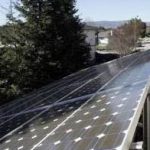In my previous article I presented the principle for avoiding production losses when photovoltaic systems are located in such cases where there is shadow of trees, dust, chimneys, antenna, other buildings … We speak of photovoltaic shading.
Then I presented a good solution to avoid these which is distributed MPP Tracking: one micro inverter per photovoltaic module to track individual Maximum Power Point. I also detailed 2 design approaches with pro’s & con’s arguments.
In this article, I will give some concerns and questions about photovoltaic reliability.
It’s a main point and certainly the success key factor of this disruptive innovation.
A manufacturer writes “no failure point”: that‘s great! But when a micro converter is embedded on the photovoltaic module and fixed on a roof, it’s not acceptable to have failure. This is not thinking to have a field engineer or installer which climb on the roof, uninstall a photovoltaic module and break water tightness (in case of BIPV) for a US50$ micro-converter part only !
The design must integrate the unfavourable constraints for the component choice (very low temperature the winter (- 20°C), very high temperature the summer (+70°C)). To be serious, a manufacturer should describe which working profile conditions are using for the design…
This is the most critical point and a lot of manufacturers are not talkative on this topic.
One indicates: “specific components are chosen for reliability design (HALT). Also those tests have run for the equivalent of over 50 years”. It’s great, but it’s not serious: the life time indicate nothing about photovoltaic reliability!
(for example : I can keep a car during 20 years (20 Years life time) and every week the car mechanic repair it (7 days MTBF))
What is the Photovoltaic reliability of distributed system? What is the true MTBF or the true “lambda” ?
How many chances have a customer to have a failure on his roof? How will customer ROI be impacted if we have to repair it during the life-time. That is the true and one question I have to request myself before suggests it on his roof!
To summarize
In my point of view this distributed technology applied to photovoltaic sytem is a very interesting new approach of solar energy harvest with a lot of benefices under specific condition. But today this technology is developed by very small companies witch take not enough in count the photovoltaic reliability aspect. It’s a shame because this innovation could be nip in the bud.
Yves Jeanjean

Maybe inverters reliability (and cost) problems will cause in future change to using DC instead AC?
why you don,t line the panel directly to the lines of electric net to delete the battery of the circle and the finally cost ,hat you can use the solar system in the light and other generatons in the dark